2. 自然资源部深地动力学重点实验室, 中国地质科学院地质研究所, 北京 100037;
3. 中国地震局地震预测研究所, 北京 100036;
4. 中国地震局地球物理研究所, 北京 100081
2. Key Laboratory of Deep-Earth Dynamics, Ministry of Natural Resources, Institute of Geology, Chinese Academy of Geological Sciences, Beijing 100037, China;
3. Institute of Earthquake Forecasting, China Earthquake Administration, Beijing 100036, China;
4. Institute of Geophysics, China Earthquake Administration, Beijing 100081, China
2008年5月12日发生的汶川特大地震(MS8.0)波及半个亚洲,发震断裂位于青藏高原东缘龙门山断裂带(图 1).汶川地震最大烈度11,余震23000余次,最大余震6.4级,余震范围长300 km,宽80 km.地震造成龙门山的两条大断裂——映秀—北川和灌县—安县断裂在90 s内分别产生270 km和80 km的巨大同震破裂(付碧宏等,2008;李海兵等,2008;李勇等,2008;刘静等,2008;许志琴等,2008;张培震等,2008;Liu-Zeng et al., 2009;Fu et al., 2011),地震还引起了极其严重的次生灾害.汶川特大地震是我国历史上损失极为惨重、波及范围广而且援救最困难的一次强烈地震,造成8万多人死亡、37万多人受伤、4500多万人失去家园,导致上万亿元的财产损失.
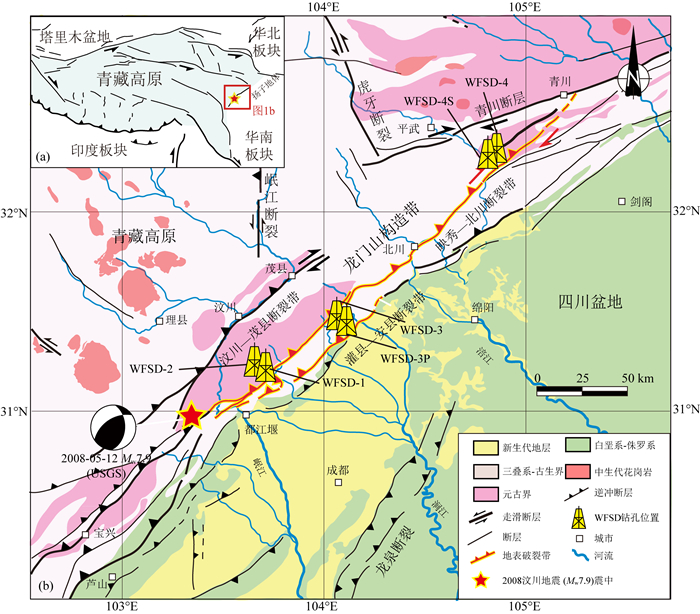
|
图 1 青藏高原东缘龙门山汶川大地震构造背景与WFSD钻孔位置图 Fig. 1 Tectonic background of the Wenchuan earthquake in the eastern margin of the Tibetan Plateau and the WFSD drilling sites |
汶川8.0级特大地震发生在无7级以上强震记录历史、地表运动甚微的龙门山断裂带上,给地学工作者带来了前所未有的强烈震撼.它告诫我们地表地质调查和GPS监测存在类似汶川8.0级特大地震潜在的强震危险盲区,同时也向地学工作者提出了严峻挑战,要求我们对地表的地壳运动监测手段、板内强震孕育的深部构造环境和深浅构造耦合关系、强震孕育的运动学和动力学过程、强震预测预报等进行重新认识,研究出地表地质调查和GPS监测难以发现的、潜在的强震危险区的探测和监测方法,避免汶川地震悲剧的重演.
我们知道,地震灾害的预报存在很大的难度,目前世界上许多国家和地区的科学家,正在千方百计利用新的科学技术,不断探索新的途径来提高对地震灾害预报预警能力,提升对地球内部变形机理的认知程度,为减轻人类遭受地震灾害的苦难而努力奋斗,从未放弃.中国台湾、日本、美国以及新西兰等地区和国家在地震活动断裂带实施科学钻探的成功经验给予我们重要的启迪:活动(地震)断裂带的科学钻探通过原位观测、井中实验、断裂带物质的实验室分析以及长期监测等手段,可以为解决地震机制的根本问题提供重要的依据(Brodsky et al., 2009;Zoback et al., 2007;Boullier,2011).
汶川大地震后178天,余震尚在继续,由科技部、国土资源部和中国地震局联合行动组织实施的汶川地震断裂带科学钻探(WFSD)于2008年11月7日在都江堰开钻(图 2).这是认识地震发生机制、对余震进行有效监控,以及提高地震监视和预警能力的极佳机遇,也是世界上最快回应大地震的科学钻探.
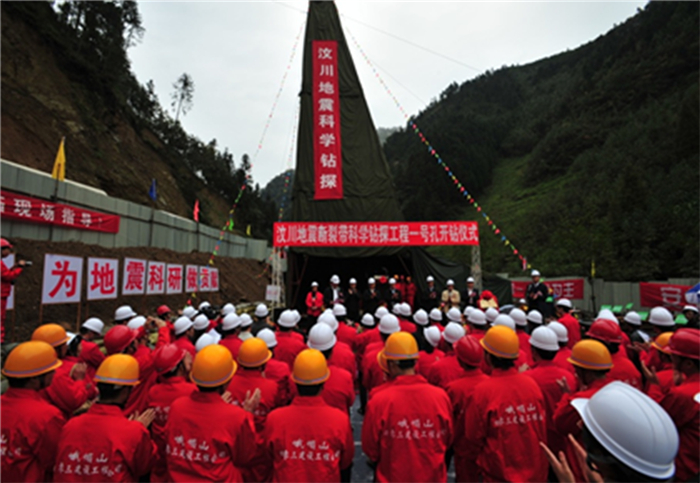
|
图 2 汶川地震断裂带科学钻探一号孔(WFSD-1)于2008年11月7日的开工典礼 Fig. 2 The commencement ceremony of the Wenchuan earthquake Fault Scientific Drilling Project Hole-1 on November 7, 2008 |
汶川地震断裂带科学钻探的科学目标是根据一系列有关汶川大地震的关键科学问题而确定的,其中一些问题是长期困扰地震学家的有关地震成因的问题.我们通过迅速回应地震的断裂带钻探来探索这些问题,关系到现代科学对强烈地震的预测能力.
1.1 关键科学问题汶川地震同时沿两条断裂发生破裂,这种类型的地震是全球有历史记载以来从未发生过的.因此引发地学家们对以下问题的思考:汶川地震究竟是在一个什么应力环境下发生的?巨大的地震破裂是如何产生的?为什么汶川地震造成映秀—北川和灌县—安县两条断裂在90 s时间内大规模的快速破裂?地下流体如何影响地震的孕育、发生、停止过程?汶川地震后的余震强度和余震持续多长时间?
1.2 科学目标和研究内容(1) 汶川地震的构造背景及深部结构
通过汶川地震断裂带科学钻探,结合主震断裂地表破裂带及构造背景研究,重塑龙门山形成演化过程及三维深部结构,阐明印度/亚洲碰撞造成的物质运动及应力集中的起因.
(2) 汶川地震发生的机理
通过科学钻探的综合研究,包括岩石学、地球化学、物理性质、构造等多方面的观测和研究,揭示汶川地震断裂带的深部物质组成、结构、产出及其构造属性;恢复地震过程中的岩石物理和化学行为、能量状态与破裂演化过程;深化认识汶川地震发生的应力环境、巨大的地震破裂产生及自南西向北东传播原因、地下流体在地震的孕育、发生、停止过程中的作用;检验和深化理解地震断裂性质和发震机理.
(3) 井孔附近微震台阵观测及余震研究
通过对汶川地震余震的精确定位、钻孔附近的地震台阵观测及定位,以及微震资料处理,确定了地震活动与龙门山断裂带不同区段的空间关系.
(4) 流体地球化学长期观测和震后效应
通过对汶川地震孕育和发生过程中断层地球化学剖面对比分析,以及汶川地震前后流体地球化学长期观测资料和流体地球化学震后效应分析,探讨孔隙压动态扩散与地震时空演化的关联,系统研究断裂带深部流体特征与构造活动的动力学关系,为确定大地震孕育过程提供深部流体活动行为的科学依据.
(5) 断裂带地震波走时连续动态监测
利用可控震源开展断裂带浅层地震勘探,探明钻孔井位区域的地层结构.通过精密控制人工震源和高精度接收系统,开展断裂带地震波走时连续动态监测.借此研究断裂带应力变化、断裂带愈合过程及其与余震的关系,为地震发生机理研究提供依据.
1.3 技术方法汶川地震断裂带科学钻探项目是中国大陆首次围绕地震灾害进行的科学钻探工程,是以探索地震机制和提高地震预报预警能力为目的的第一次科学尝试,以“钻探-井中探测-科学研究”三位一体以及高技术井中探测和科学前沿紧密结合为本项目的特色.
本项目对大地震和微震的源区进行直接取样,采用一系列先进的观测和分析手段,开展地质构造、地震地质、岩石力学、化学物理、地震物理、流体作用和流变学等多学科研究,揭示控制断裂作用及地震发生的物理和化学作用,为未来地震的监测、预报或预警提供最基础的数据.
(1) 通过在汶川地震断裂带实施的共约9000 m深度的6口科学钻井,以及流体、应力、渗透性、地震波速等的测量和研究,建立地震断裂带系列岩性、构造、物理-化学性质、测井、温度、摩擦、流体和地应力剖面;揭示巨大断裂滑移量及滑移速度与断裂摩擦的关系;研究温度变化与摩擦系数的关系;重塑破裂演化过程;深化认识地震断裂带的地震能量状态、地震愈合周期以及断裂带物理-化学行为对地震发生机制的制约.
(2) 在精确校正钻探测井和岩心深度的前提下,综合地球物理测井、岩心的良好保存以及主动震源地震成像和观测,准确识别活动断裂位置、结构、产状及各种构造要素,精确测量断裂破坏带的宽度和破坏强度,并划分断层岩的类型,识别汶川地震破裂带结构、构造属性.
(3) 通过地震断裂带岩石、矿物和流体地球化学特征和局部熔融的研究,限定断裂带的热历史,提供热异常证据及其时空变化.深化认识流体在地震孕育、发生和停止过程中的作用.
(4) 通过汶川地震断裂带科学钻探、地表破裂及构造背景研究,重塑龙门山构造格架及造山演化过程;结合横穿龙门山的地球物理剖面的探测,揭示三维深部结构;进行青藏高原活动构造和汶川地震背景的研究,阐明印度/亚洲碰撞造成的物质运动及应力集中的起因,揭示汶川地震发生的机理.
(5) 通过安装井中地震仪和综合地球物理探测仪,井下长期观察和监测更深部的地震活动及进行地震后应力衰减的测量和记录.从三维地震台阵的角度,对汶川地震断裂带的余震趋势、余震强度和影响范围进行新的分析和探讨.
2 主要科研成果 2.1 建立汶川地震断裂带科学钻孔的系列剖面在汶川地震断裂带科学钻探工程下,完成约9000 m科学钻井(WFSD-1、WFSD-2、WFSD-3P、WFSD-3、WFSD-4和WFSD-4S)的系列地下剖面,包括岩性剖面、构造剖面(岩石产状、微断裂和破裂)、流体剖面、岩石物性剖面、矿化剖面、测井剖面、地应力剖面和重力剖面等(张伟等,2012;杨光等,2012;王焕等,2013;Li et al., 2013, 2014, 2016;Si et al., 2014;张蕾等,2017;Zhang et al., 2017).这些剖面分别呈现出各种参数随深度变化的特征,有助于我们更加全面认识地表下的断裂带特征,并且通过异常值,判断出地震主滑动带位置.
例如,图 3为汶川地震断裂带科学钻探2号孔(WFSD-2)的岩性剖面和测井剖面及裂隙密度剖面.WFSD-2钻孔岩性剖面是6口井中深度最大的,也是目前龙门山构造带中深度最大的岩性剖面,较完整地呈现了龙门山中段的主要岩石单元(张伟等,2012;张蕾等,2017).WFSD-2钻孔岩心由彭灌杂岩体和上三叠统须家河组组成(图 3b).彭灌杂岩的岩性主要为花岗岩、闪长岩和火山碎屑岩(图 3a),包括一段(499.03~599.43 m)、二段(1211.49~1360.25 m)、三段(1361.26~1679.51 m)、四段(1715.48~2081.47 m).须家河组的岩性主要是砂岩、粉砂岩、泥岩、页岩、煤层(线)和砾岩(图 3a),包括上段(599.43~1211.49 m)、中段(1679.51~1715.48 m)、下段(2081.47~2283.56 m).从图中可以看出,WFSD-2钻孔岩心中发育了大小规模不一的断层带,每一条断层带由不同的断层岩组成.其断层泥的厚度变化不等,从几毫米到几米都有发育,其中最厚的达到6 m,分布在1679.51~1698.66 m深处,碎裂岩通常与断层泥、断层角砾岩等混合出现(图 3a).从图 3c—3h可以看出,除钻孔直径外,其他测井数值的变化与岩石单元的分布呈现出一定的规律.彭灌杂岩体的自然伽马和P波速率较须家河组沉积岩低,而其电阻率、密度、孔隙度则较须家河组地层高.图 3i反映了WFSD-2整个钻孔岩心的破碎程度.宏观上看,WFSD-2钻孔岩心整体非常破碎.破裂密度显示WFSD-2钻孔岩心在彭灌杂岩一段下部之后存在大量的破裂,存在破裂的地方的破裂密度最大超过每米110条,平均破裂密度约为33.01条/m(图 3i),表明龙门山地区的强震并不只影响断裂带附近,其影响范围很广,暗示龙门山地区构造活动非常强烈(张伟等,2012).
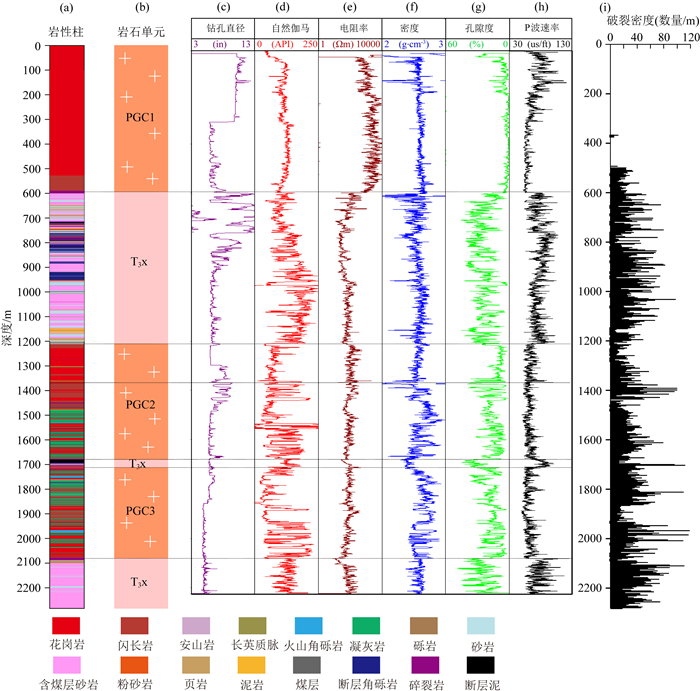
|
图 3 汶川地震断裂带科学钻探(WFSD-2)岩性和测井剖面及破裂密度剖面 (a)岩性柱状图;(b)岩石单元;(c)钻孔深度;(d)自然伽马;(e)电阻率;(f)密度;(g)孔隙度;(h) P波速率;(i)岩心破裂密度.PGC:彭灌杂岩体;T3x:须家河组地层;PSZ:主滑动带.黑色虚线为岩石单元的界线. Fig. 3 Lithology chart, logging profiles and crack density in core of the WFSD-2 (a) Lithology chart; (b) Rock units; (c) Borehole depth; (d) Natural gamma; (e) Resistivity; (f) Density; (g) Porosity; (h) P-wave velocities; (i) Crack density in core.PGC: Neoproterozoic Pengguang Complex; T3x: Xujiahe formation; PSZ: principal slip zone.The black dashed lines represent the boundaries of rock units. |
汶川大地震沿龙门山映秀—北川断裂形成270 km长的破裂带.通过映秀—北川断裂带南段虹口乡八角庙地表露头和汶川科钻岩心研究,确定呈西倾铲式产出的映秀—北川断裂带为高角度逆冲走滑断裂带,发育有碎裂岩、假玄武玻璃、断层泥、断层角砾岩等多种类型的断裂岩,总体走向N55°—65°E,断裂带宽约240 m.地表和钻孔岩心中均发现有多期次断裂岩熔融形成的假玄武玻璃(Wang et al., 2015;Zhang et al., 2017),暗示着该断裂带在地质历史上曾多次发生大地震.综合调查发现映秀—北川断裂带由5个具不同特征的断裂岩带组成,具有多核结构特征(Wang et al., 2014).不同断裂岩组合及其结构特征显示,每次地震断裂的活动具有向下盘迁移的趋势(王焕等, 2010, 2013).映秀—北川断裂带是一条长期闭锁的、易产生大地震的高角度逆冲走滑断裂带,具有长期地震演化历史.在对汶川科钻1号孔(WFSD-1)岩心及断裂岩详细研究的基础上,识别出约590 m深处为汶川地震主滑动带所在的位置.其中有一处新鲜的深黑色断层泥(589.17~589.25 m孔深) (图 4a),颗粒相对较细且均匀,从显微照片中可见断层泥中面理构造发育,而且有S-C构造和不对称的旋转构造(图 4b),指示着明显的剪切方向(Li et al., 2013;王焕等,2015).在裂开的断面上发育有断层滑动留下的擦痕(Kuo et al., 2014)且具有润滑作用的石墨(图 4c,4d,Kuo et al., 2014).具有高磁化率特征(Li et al., 2013)和温度、测井、随钻流体、黏土矿物成分异常(唐力君等,2013;Li et a1., 2013,2014;Si et al., 2014),表明该断面为断层主要滑动面.断层泥出现高磁化率值可能是由于断层滑动过程中摩擦产生的高温作用形成新的磁性矿物或含磁矿物成分增加所致(Hirono et al., 2006, 2008;Mishima et al., 2006, 2009;Tanikawa et al., 2007, 2008;Chou et al., 2012;Yang et al., 2012a, 2012b, 2013),说明地震过程中断层滑动摩擦产生了高温,且因此导致一系列物理、化学变化.

|
图 4 WFSD-1岩心中汶川地震主滑移带(PSZ)特征(据Li et al., 2013;Kuo et al., 2014) (a)岩心589.2 m深处发育汶川地震同震断层泥;(b)主滑移带显微结构特征;(c)主滑移带局部扫描电镜背散射图像,显示PSZ厚度~200 μm,局部富含石墨; (d)透射电镜图像显示纳米级石墨颗粒. Fig. 4 Characteristics of the principal slip zone (PSZ) of the Wenchuan earthquake in the WFSD-1 core (after Li et al., 2013; Kuo et al., 2014) (a) Coseismic fault gouge of the Wenchuan earthquake in WFSD-1 drilling cores; (b) Microstructures of the PSZ; (c) SEM-BSE image shows Wenchuan earthquake PSZ is ~200 μm-thick and locally rich in graphite; (d) TEM image shows nano-scale graphite particles. |
(1) 确定断层泥石墨化为地震化石
通过对589.21~589.22 m孔深主滑动带中颗粒相对较细、均匀的岩石薄片进行扫描电镜(SEM)和透射电镜(TEM)分析研究,发现了一个约100~200 μm厚的粒度较小(≤10 μm)的滑动层(图 4c),结合同步辐射X射线衍射(XRD)测试和分析,发现该层中不仅有蒙脱石矿物,还富集石墨(图 4c,4d).而这些石墨是通过热激活从无序的有机化合物或非晶质的含碳物质渐进地和不可逆转地转化为稳定石墨(Buseck and Beyssac, 2014).因此,含碳物质的晶序增加与石墨化相关,这被广泛应用于指示沉积层和变质岩所达到的最高温度(Barker and Goldstein, 1990;Beyssac et al., 2002).滑动带中石墨的存在说明地震过程中断裂滑移机制是以热增压为主,同时表明汶川地震断裂强度极低(Kuo et al., 2014;王焕等,2015).石墨沿滑移带的富集不仅可以作为上地壳地震滑移期间瞬时摩擦生热的标志,而且可以作为判断大地震发生的标志(Kuo et al., 2014, 2017).这一结果对认识汶川地震破裂过程及古地震的判定具有重要意义.
(2) 发现和确定目前世界上最低的地震断层摩擦系数
WFSD-1钻孔完钻之后, 对钻井内温度和水位变化进行了长期的测量.长期温度测量剖面显示,汶川地震主滑移面的温度异常在监测期间从震后一年的0.15 ℃降至0.02 ℃(图 5a),之后该异常随时间的推移未见明显变化.汶川地震过程中摩擦导致的热量远小于29 MJ·m-2 (Li et al., 2015).通过有关滑动过程中形成的摩擦热,温度在断层面上一维可导的衰减公式,有效正压力以断层面上覆岩体减去水压,0.02 ℃的最大值意味着在589 m深处有效的动摩擦系数小于0.02 (Li et al., 2015).考虑到同震位移为7 m的话,这是目前为止自然界断层中获得的最低摩擦系数,远低于一般高速摩擦实验中观察到的最低值0.1(Di Toro et al., 2011) (图 5b)和在湿的环境下龙门山断层泥的高速摩擦实验中得到的0.06(Togo et al., 2016).断层带中有机碳质、黏土矿物以及石墨等均是导致这一现象的可能因素(Zhang and He, 2013;Kuo et al., 2014).汶川地震过程中具有极低的摩擦系数的断层可能经历强烈的弱化作用.从而直接回答了长期困扰在地震地质和地震物理学领域的关键问题——为什么汶川地震可以使断层滑动破裂几百公里长?

|
图 5 WFSD-1钻孔内长期温度及水位监测 (a) 0.02 ℃的残余热;(b) WFSD-1钻孔中跨断层温度异常的最大振幅估算的断裂有效同震摩擦系数(μ=0.02)(据Li et al., 2015);(c)渗透率和透水系数(据Xue et al., 2013). Fig. 5 Temperature and water level monitoring in the WFSD-1 hole (a) 0.02 ℃ residual temperature; (b) Predicted maximum amplitude of the temperature anomaly for the fault in the WFSD-1 borehole with representative effective coseismic coefficients of friction (after Li et al., 2015); (c) Permeability and transmissivity (after Xue et al., 2013). |
(3) 汶川地震发生后断裂快速愈合
断裂带中渗透率变化可以反映其裂隙的发育和愈合情况,也是地震断层强化重新获取能量的指示(Gratier,2011).通过有效的渗透率与透水系数之间的关系,计算得出汶川断层破裂带在测量时间段内800~1201 m深处的有效渗透率平均值为1.4×10-15 m2,该值比实验室测量的断裂岩样品和须家河组整体岩石的渗透率值以及其他已知断层带的渗透率值高(Lockner et al., 2000;Zhu et al., 2009),其差值很可能受控于裂隙的发育情况(Caine et al., 1996),也表明汶川地震发生时断层附近有显著的地下水流动,而地下水的流动会影响断层附近的有效正应力及摩擦热,从而影响了地震的破裂过程.随钻长期水位监测显示映秀—北川断裂带内渗透率快速下降(图 5c),这种现象反映了震后断裂闭合或者连通性降低,即映秀—北川断裂带的震后快速愈合过程(Xue et al., 2013),对于当地的孕震机制以及地震周期有指示意义.研究得到汶川地震破裂带水力扩散系数的平均值为0.024 m2·s-1,比1999年集集地震后在车笼铺断裂带所测的值(7×10-5 m2·s-1,Doan et al., 2006)大,这意味着在地震过程中破裂发育程度和同震滤水性是非常重要的.
另外,结合汶川8.0级地震余震矩张量时空分布特征(林向东等,2012)和井水位资料分析,汶川8.0级地震的余震主要以逆冲和走滑为主,与主震破裂的滑移分布特征具有一致性,随着时间的推移,矩张量主要类型由逆冲走滑断层变为逆断层,同时井水位资料分析的渗透率的变化也相应随时间逐渐减小至震前的水平.综合来看龙门山断裂带约在2009年5月份以后已经基本愈合(林向东等,2012).
2.4 重建青藏高原东缘构造格架,提出白垩纪以来新的龙门山造山模式龙门山位于青藏高原东缘,西接松潘—甘孜造山带,东临扬子陆块的四川盆地.龙门山是个奇特的山脉,以陡立地形(3000~4500 m高差,Densmore et al., 2007)、剧变的地壳厚度(龙门山下52.5 km减到四川盆地下的41.5 km,王椿镛等,2010)、极小的地壳水平缩短量以及无新生代沉积为特征(Chen et al., 2000;Shen et al., 2005;Burchfiel et al., 2008).青藏高原岩石圈和软流圈的向东生长将受到刚性的四川盆地所阻拦.长期以来两种观点解释龙门山的隆升:向东的低速中下地壳隧道流受刚性的扬子陆块阻挡(图 6a;Royden et al., 1997;Clark and Royden, 2000,2008;Burchfiel et al., 2008)和逆冲断裂引起地壳增厚(图 6b;Hubbard and Shaw, 2009).
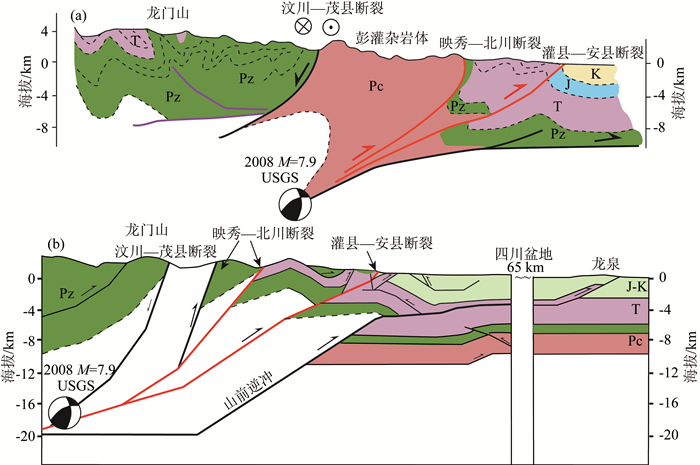
|
图 6 龙门山隆升的两种观点 (a)向东的低速中下地壳隧道流受刚性的扬子陆块阻挡(据Burchfield et al., 2008); (b)逆冲断裂引起地壳增厚(据Hubbard and Shaw, 2009).Pc—前寒武系;Pz—古生界;T—三叠系;J—侏罗系;K—白垩系. Fig. 6 Two opinions of the Longmen Shan uplift (a) The low velocity of the crust channel flow blocked by the rigid Yangtze block (after Buchfield et al., 2008); (b) Crustal thickening caused by the thrust faults (after Hubbard and Shaw, 2009). Pc—Precambrian; Pz—Paleozoic; T—Triassic; J—Jurassic; K—Cretaceous. |
结合龙门山主震断裂带地表破裂区域地质调查、汶川地震断裂带钻孔资料及深部地震反射剖面的资料,重塑龙门山的构造构架,提出山脉形成的新模式.
(1) WFSD-1和WFSD-2钻孔资料揭示龙门山中段存在彭灌杂岩的多重逆冲岩片构造.因此,龙门山构造格架由白垩纪以来的挤出岩片和逆冲叠覆岩片组成(图 7).龙门山新元古代彭灌—康定杂岩的西侧为大型彭灌韧性拆离剪切带(PGD),形成年代为120—110 Ma,东侧发育映秀—北川韧性逆冲剪切带(YBT).两条边界夹持的彭灌—康定杂岩构成龙门山的主要构造单元——白垩纪形成的彭灌挤出岩片.WFSD-1和WFSD-2钻孔联合剖面、横穿龙门山中段的反射地震剖面揭示彭灌挤出岩片底界向西缓倾延伸至汶川—茂县断裂之下6 km的深度,为无根的挤出岩片.
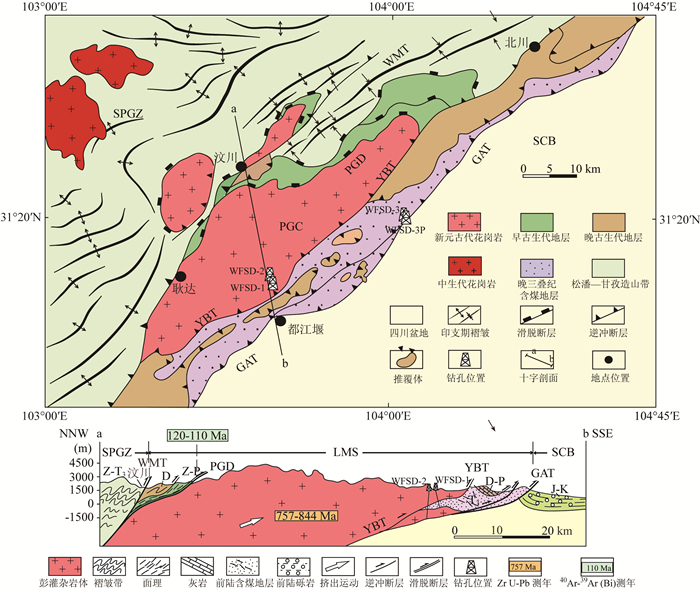
|
图 7 龙门山构造格架重建示意图.由彭灌杂岩组成的挤出岩片与叠置逆冲岩片组成 SCB—四川盆地;SPGZ—松潘甘孜造山带;LMS—龙门山;PGC—彭灌杂岩;GAT—灌县—安县逆冲断裂;YBT—映秀—北川逆冲断裂;PGD1和PGD2—彭灌拆离断裂系.WMT—汶川—茂县逆冲断裂. Fig. 7 Schematic diagram shown the structural framework of the Longmen Shan. It is made up of extrusion rocks and stack thrust rocks of Pengguan Complex SCB—Sichuan basin; SPGZ—Songpan-Garzê orogenic zone; LMS—Longmen Shan; PGC—Pengguan Complex; GAT— Guanxian-Anxian thrust belt; YBT—Yingxiu-Beichuan thrust belt; PGD1 & PGD2—Pengguan detachment fault system; WMT—Wenchuan-Maoxian thrust belt. |
(2) 龙门山彭灌挤出岩片前缘为一系列向西倾覆的新生代逆冲叠置岩片,四川盆地之下的新元古代基底和盖层之间发育向东运动的滑脱断层,基底卷入向西倾斜的逆冲断裂体系之中(图 7).
(3) 青藏高原东缘40 Ma以来的隆升机制.龙门山西侧PGD向西延至松潘甘孜的丹巴地区的基底和盖层之间,并揭示PGD的冷却快速抬升年龄为40 Ma,结合大地电磁资料(Zhao et al., 2012),重新解释在松潘—甘孜造山带拆离之下20~30 km深处代表弱的中下地壳流的高导-低阻-低速带与该区40 Ma以来的伸展背景形成的拆离构造以及其与隆升的相关性.而龙门山和四川盆地深部由低导-高阻-低速体代表扬子陆块和龙门山下部的刚性体性质,揭示上部地壳水平缩短60 km,垂直抬升12 km的挤出和叠覆逆冲岩片,与隧道流无关.地震震中发生在龙门山之下的扬子克拉通中的基底与盖层滑脱断裂附近,因此龙门山的形成造成扬子克拉通的长期破坏和应力积累,可能是导致汶川地震爆发的主要原因.
2.5 汶川地震余震记录与精定位利用龙门山及邻区2008年5月12日汶川地震后4年中中国地震台网记录到的93837条余震事件为基础,开展地震精定位研究.获得Hyp2000绝对定位方法43297个地震和HypoDD相对定位方法(双差定位法)32797个地震精定位结果.分析了汶川地震余震序列的时空分布与演化特征,汶川地震的余震深度集中在10~20 km,沿龙门山断裂的地震分布具有明显的分段性,西南段呈水平带状分布,表现为逆冲,东北段接近垂直分布,与走滑现象相吻合(吕鹏等,2011;李丽等,2018).汶川余震精定位应用于余震活动期间的流体孔隙压力扩散特征跟踪研究(陈涛等,2012).基于精定位数据和震源机制相似性,用孔隙压力扩散机制分析了余震的时空分布,认为深部流体的运移影响余震的时空演化过程(Liu et al., 2014).利用数值模拟分析余震活动的时空分布以及孔隙压力的变化情况.沿活动断裂运用孔隙压力扩散公式能够表示龙门山断裂带的余震震源迁移的信息.在2008年5月和12月范围内的余震活动分为三个与流体扩散过程相关的阶段,随着时间的延长,孔隙压力扩散有逐渐增加趋势,并且在空间上,孔隙压扩散系数自北向南逐渐增大.而且,汶川地震的强烈余震主要出现在断层北段,说明孔隙压力扩散的南北差异与余震的强度相关(Liu et al., 2014).还有一些学者认为,深部流体在汶川地震和余震活动中起重要作用.例如,雷建设等(2009)通过P波速度资料,反演了龙门山断裂带及其周边地区的地壳精细结构,发现汶川主震震源区下方存在明显低波速异常体,认为龙门山断裂带内存在流体并对地震起直接作用.周永胜和何昌荣(2009)建立了汶川地震相关构造单元的地壳流变结构,认为复杂的流变结构是汶川地震发生的基础,其中龙门山断层带中的高流体孔隙压力是触发汶川地震的必要条件.该主题的综合分析可以帮助我们更深入地了解流体在地震时空演化中的作用和更好地评估地震危害.
3 成果转化与前景评价龙门山断裂带历史上发生过许多次地震,地层破碎的严重程度罕见,仅WFSD-1孔就钻遇20多条断裂带.所有的钻孔从开钻到完钻基本上都在破碎地层中钻进,施工条件十分恶劣,钻孔垮塌、扩径、缩径和漏失等诸多困难同存,给取心和钻进带来了很大困难,还导致钻探事故频发.处理事故和侧钻施工耗费了大量的时间和经费,导致了钻探工期后延.
汶川地震断裂带科学钻探研发成功一套多功能、低成本的深孔取心钻探设备KZ-3000-DB型钻机和配套器具.采用高转速交流变频顶驱,适合于直径和深度较大的连续取心钻进施工,用于3000 m左右的科学钻探,解决缩径带钻进问题的偏心扩孔取心钻头和偏心扩孔器阶梯式隔水防冲蚀取心钻头提高破碎地层的岩心采取率,还可用于深孔地质勘探、地热钻探、煤层气钻探和浅层石油钻探.研发的螺杆马达/液动锤/长半合管取心钻进工艺首次在世界上得到应用,获得了显著的效果.
4 结论汶川地震断裂带科学钻探工程(WFSD)是我国大陆围绕特大地震开展的首次地震断裂科学钻探项目,是世界上最快回应大地震的科学钻探,引起国内外地学界的高度重视.在尚有强烈余震的险峻山体上和在强烈破碎的汶川地震断裂带上,进行钻探、测井、监测、取心和研究,具有很大冒险性和探索性.尽管经历重重困难,该项目仍然取得许多重要的研究进展,特别是对地震成因机理研究的突破,如提出断裂带内石墨可作为判断大地震发生的标志,发现和确定了目前世界上最低的断层有效动摩擦系数,第一次记录到大震后断裂带快速愈合信息等成果引起国际地震界的重视.不得不指出,由于钻探环境恶劣,岩性严重破碎,缺乏应对快速回应大地震的经验,以及由于钻探工程的滞后而影响研究的进程,许多相关领域的研究仍在继续之中.科学钻探目标的实现本身具有很大的探索性,需要地学家们今后的继续努力进取和突破.
致谢本项目的实施得到科技部、国土资源部、中国地震局、四川省政府和部队的大力支持,在中国地质调查局的直接领导下和参加项目的全部人员的倾力合作,项目得以顺利完成.在此一并表示衷心的感谢.感谢两位评阅人提出的修改意见,使本文更加完善.
Barker C E, Goldstein R H.
1990. Fluid-inclusion technique for determining maximum temperature in calcite and its comparison to the vitrinite reflectance geothermometer. Geology, 18(10): 1003-1006.
DOI:10.1130/0091-7613(1990)018<1003:FITFDM>2.3.CO;2 |
|
Beyssac O, Rouzaud J N, Goffé B, et al.
2002. Graphitization in a high-pressure, low-temperature metamorphic gradient: A Raman microspectroscopy and HRTEM study. Contributions to Mineralogy and Petrology, 143(1): 19-31.
DOI:10.1007/s00410-001-0324-7 |
|
Boullier A M.
2011. Fault-zone geology: Lessons from drilling through the Nojima and Chelungpu faults. Geological Society, London, Special Publications, 359(1): 17-37.
DOI:10.1144/SP359.2 |
|
Brodsky E E, Ma K F, Mori J, et al. 2009. Rapid response fault drilling past, present, and future. Report of the ICDP/SCEC International Workshop: Rapid Response Fault Drilling, Tokyo, 17-19.
|
|
Burchfiel B C, Royden L H, Van Der Hilst R D, et al.
2008. A geological and geophysical context for the Wenchuan earthquake of 12 May 2008, Sichuan, People's Republic of China. GSA Today, 18(7): 4-11.
DOI:10.1130/GSATG18A.1 |
|
Buseck P R, Beyssac O.
2014. From organic matter to graphite: Graphitization. Elements, 10(6): 421-426.
DOI:10.2113/gselements.10.6.421 |
|
Caine J S, Evans J P, Forster C B.
1996. Fault zone architecture and permeability structure. Geology, 24(11): 1025-1028.
DOI:10.1130/0091-7613(1996)024<1025:FZAAPS>2.3.CO;2 |
|
Chen T, Liu Y W, Yang D X, et al.
2012. The role of pore pressure in earthquake triggering and process of swarm earthquakes and aftershocks. Progress in Geophysics, 27(6): 2407-2417.
DOI:10.6038/j.issn.1004-2903.2012.06.015 |
|
Chen Z, Burchfiel B C, Liu Y, et al.
2000. Global positioning system measurements from eastern Tibet and their implications for India/Eurasia intercontinental deformation. Journal of Geophysical Research: Solid Earth, 105(B7): 16215-16227.
DOI:10.1029/2000JB900092 |
|
Chou Y M, Song S R, Aubourg C, et al.
2012. An earthquake slip zone is a magnetic recorder. Geology, 40(6): 551-554.
DOI:10.1130/G32864.1 |
|
Clark M K, Royden L H.
2000. Topographic ooze: Building the eastern margin of Tibet by lower crustal flow. Geology, 28(8): 703-706.
DOI:10.1130/0091-7613(2000)28<703:TOBTEM>2.0.CO;2 |
|
Cook K L, Royden L H.
2008. The role of crustal strength variations in shaping orogenic plateaus, with application to Tibet. Journal of Geophysical Research: Solid Earth, 113(B8): B08407.
DOI:10.1029/2007JB005457 |
|
Densmore A L, Ellis M A, Li Y, et al.
2007. Active tectonics of the Beichuan and Pengguan faults at the eastern margin of the Tibetan Plateau. Tectonics, 26(4): TC4005.
DOI:10.1029/2006TC001987 |
|
Di Toro G, Han R, Hirose T, et al.
2011. Fault lubrication during earthquakes. Nature, 471(7339): 494-498.
DOI:10.1038/nature09838 |
|
Doan M L, Brodsky E E, Kano Y, et al.
2006. In situ measurement of the hydraulic diffusivity of the active Chelungpu fault, Taiwan. Geophysical Research Letters, 33(16): 373-386.
|
|
Fu B H, Wang P, Kong P, et al.
2008. Preliminary study of coseismic fault gouge occurred in the slip zone of the Wenchuan MS8.0 earthquake and its tectonic implication. Acta Petrologica Sinica, 24(10): 2237-2243.
|
|
Fu B H, Shi P L, Guo H D, et al.
2011. Surface deformation related to the 2008 Wenchuan earthquake, and mountain building of the Longmen Shan, eastern Tibetan Plateau. Journal of Asian Earth Sciences, 40(4): 805-824.
DOI:10.1016/j.jseaes.2010.11.011 |
|
Gratier J P.
2011. Fault permeability and strength evolution related to fracturing and healing episodic processes (years to millennia): The role of pressure solution. Oil & Gas Science and Technology, 66(3): 491-506.
|
|
Hirono T, Lin W R, Yeh E C, et al.
2006. High magnetic susceptibility of fault gouge within Taiwan Chelungpu fault: Nondestructive continuous measurements of physical and chemical properties in fault rocks recovered from Hole B, TCDP. Geophysical Research Letters, 33(15): L15303.
DOI:10.1029/2006GL026133 |
|
Hirono T, Fujimoto K, Yokoyama T, et al.
2008. Clay mineral reactions caused by frictional heating during an earthquake: An example from the Taiwan Chelungpu fault. Geophysical Research Letters, 35(16): L16303.
DOI:10.1029/2008GL034476 |
|
Hubbard J, Shaw J H.
2009. Uplift of the Longmen Shan and Tibetan plateau, and the 2008 Wenchuan (M=7.9) earthquake. Nature, 458(7235): 194-197.
DOI:10.1038/nature07837 |
|
Kuo L W, Li H B, Smith S A F, et al.
2014. Gouge graphitization and dynamic fault weakening during the 2008 MW7.9 Wenchuan earthquake. Geology, 42(1): 47-50.
DOI:10.1130/G34862.1 |
|
Kuo L W, Di Felice F, Spagnuolo E, et al.
2017. Fault gouge graphitization as evidence of past seismic slip. Geology, 45(11): 979-982.
DOI:10.1130/G39295.1 |
|
Lei J S, Zhao D P, Su J R, et al.
2009. Fine seismic structure under the Longmenshan fault zone and the mechanism of the large Wenchuan earthquake. Chinese Journal of Geophysics, 52(2): 339-345.
|
|
Li H B, Fu X F, Van Der Woerd J, et al.
2008. Co-seismic surface rupture and dextral-slip oblique thrusting of the MS8.0 Wenchuan earthquake. Acta Geologica Sinica, 82(12): 1623-1643.
|
|
Li H B, Wang H, Xu Z Q, et al.
2013. Characteristics of the fault-related rocks, fault zones and the principal slip zone in the Wenchuan Earthquake Fault Scientific Drilling Project Hole-1 (WFSD-1). Tectonophysics, 584: 23-42.
DOI:10.1016/j.tecto.2012.08.021 |
|
Li H B, Xu Z Q, Niu Y X, et al.
2014. Structural and physical property characterization in the Wenchuan earthquake Fault Scientific Drilling project-hole 1 (WFSD-1). Tectonophysics, 619-620: 86-100.
DOI:10.1016/j.tecto.2013.08.022 |
|
Li H B, Xue L, Brodsky E E, et al.
2015. Long-term temperature records following the MW7.9 Wenchuan (China) earthquake are consistent with low friction. Geology, 43(2): 163-166.
DOI:10.1130/G35515.1 |
|
Li H B, Wang H, Yang G, et al.
2016. Lithological and structural characterization of the Longmen Shan fault belt from the 3rd hole of the Wenchuan Earthquake Fault Scientific Drilling project (WFSD-3). International Journal of Earth Sciences, 105(8): 2253-2272.
DOI:10.1007/s00531-015-1285-9 |
|
Li L, Adhikari L B, Li G, et al.
2018. A temporal-spatial investigation of the aftershocks of the Wenchuan Earthquake (MS8.0, 12 May 2008). Chinese Journal of Geophysics.
|
|
Li Y, Zhou R J, Dong S L, et al.
2008. Surface rupture, thrusting and strike-slipping in the Wenchuan earthquake of Sichuan, China. Journal of Chengdu University of Technology (Science & Technology Edition), 35(4): 404-413.
|
|
Lin X D, Dreger D, Ge H K, et al.
2012. The spatial and temporal distribution of moment tensors of Wenchuan aftershocks. Recent Developments in World Seismology(6): 37.
|
|
Liu J, Zhang Z H, Wen L, et al.
2008. The MS8.0 Wenchuan earthquake co-seismic rupture and its tectonic implications-an out of sequence thrusting event with slip partitioned on multiple faults. Acta Geologica Sinica, 82(12): 1707-1722.
|
|
Liu Y W, Chen T, Xie F R, et al.
2014. Analysis of fluid induced aftershocks following the 2008 Wenchuan MS8.0 earthquake. Tectonophysics, 619-620: 149-158.
DOI:10.1016/j.tecto.2013.09.010 |
|
Liu-Zeng J, Zhang Z, Wen L, et al.
2009. Co-seismic ruptures of the 12 May 2008, MS8.0 Wenchuan earthquake, Sichuan: East-west crustal shortening on oblique, parallel thrusts along the eastern edge of Tibet. Earth and Planetary Science Letters, 286(3-4): 355-370.
DOI:10.1016/j.epsl.2009.07.017 |
|
Lockner D A, Naka H, Tanaka H, et al. 2000. Permeability and strength of core samples from the Nojima fault of the 1995 Kobe earthquake. //Ito H, Fujimoto K, Tanaka H, eds. Proceedings of the Internal Workshop on Nojima Fault Core & Borehole Date Analysis. Tsukuba, Japan, USGS.
|
|
Lv P, Ding Z F, Zhu L P.
2011. Application of double-difference relocation technique to aftershocks of 2008 Wenchuan earthquake using waveform cross-correlation. Acta Seismologica Sinica, 33(4): 407-419.
|
|
Mishima T, Hirono T, Nakamura N, et al.
2009. Changes to magnetic minerals caused by frictional heating during the 1999 Taiwan Chi-Chi earthquake. Earth, Planets and Space, 61(6): 797-801.
DOI:10.1186/BF03353185 |
|
Mishima T, Hirono T, Soh W, et al.
2006. Thermal history estimation of the Taiwan Chelungpu fault using rock-magnetic methods. Geophysical Research Letters, 33(23): 265-288.
DOI:10.1029/2006GL028088 |
|
Royden L H, Burchfiel B C, King R W, et al.
1997. Surface deformation and lower crustal flow in eastern Tibet. Science, 276(5313): 788-790.
DOI:10.1126/science.276.5313.788 |
|
Shen Z K, Lü J N, Wang M, et al.
2005. Contemporary crustal deformation around the southeast borderland of the Tibetan Plateau. Journal of Geophysical Research: Solid Earth, 110(B11): B11409.
DOI:10.1029/2004JB003421 |
|
Si J L, Li H B, Kuo L W, et al.
2014. Clay mineral anomalies in the Yingxiu-Beichuan fault zone from the WFSD-1 drilling core and its implication for the faulting mechanism during the 2008 Wenchuan earthquake (MW7.9). Tectonophysics, 619-620(5): 171-178.
|
|
Tang L J, Wang G, Wang J, et al.
2013. Responding features of fluids during drilling of the main fracture zone in WFSD-1 Hole. Acta Geoscientica Sinica, 34(1): 95-102.
|
|
Tanikawa W, Mishima T, Hirono T, et al.
2007. High magnetic susceptibility produced in high-velocity frictional tests on core samples from the Chelungpu fault in Taiwan. Geophysical Research Letters, 34(15): L15304.
DOI:10.1029/2007GL030783 |
|
Tanikawa W, Mishima T, Hirono T, et al.
2008. High magnetic susceptibility produced by thermal decomposition of core samples from the Chelungpu fault in Taiwan. Earth and Planetary Science Letters, 272(1-2): 372-381.
DOI:10.1016/j.epsl.2008.05.002 |
|
Togo T, Yao L, Ma S L, et al.
2016. High-velocity frictional strength of Longmenshan fault gouge and its comparison with an estimate of friction from the temperature anomaly in WFSD-1 drill hole. Journal of Geophysical Research: Solid Earth, 121(7): 5328-5348.
DOI:10.1002/2016JB012880 |
|
Wang C Y, Lou H, Yao Z X, et al.
2010. Crustal thicknesses and Poisson's ratios in Longmenshan Mountains and adjacent regions. Quaternary Sciences, 30(4): 652-661.
|
|
Wang H, Li H B, Pei J L, et al.
2010. Structural and lithologic characteristics of the Wenchuan earthquake fault zone and its relationship with the seismic activity. Quaternary Sciences, 30(4): 768-778.
|
|
Wang H, Li H B, Si J L, et al.
2013. The relationship between the internal structure of the Wenchuan earthquake fault zone and the uplift of the Longmenshan. Acta Petrologica Sinica, 29(6): 2048-2060.
|
|
Wang H, Li H B, Si J L, et al.
2014. Internal structure of the Wenchuan earthquake fault zone, revealed by surface outcrop and WFSD-1 drilling core investigation. Tectonophysics, 619-620(5): 101-114.
|
|
Wang H, Li H B, Si J L, et al.
2015. Progress in the study of the Wenchuan earthquake faulting. Acta Geoscientica Sinica, 36(3): 257-269.
|
|
Wang H, Li H B, Janssen C, et al.
2015. Multiple generations of pseudotachylyte in the Wenchuan fault zone and their implications for coseismic weakening. Journal of Structural Geology, 74: 159-171.
DOI:10.1016/j.jsg.2015.03.007 |
|
Xu Z Q, Li H B, Wu Z L.
2008. Wenchuan earthquake and scientific drilling. Acta Geologica Sinica, 82(12): 1613-1622.
|
|
Xue L, Li H B, Brodsky E E, et al.
2013. Continuous permeability measurements record healing inside the Wenchuan earthquake fault zone. Science, 340(6140): 1555-1559.
DOI:10.1126/science.1237237 |
|
Yang G, Li H B, Zhang W, et al.
2012. Features of the Anxian-Guanxian fault zone in Longmenshan area of Sichuan Province: A case study of No.3 hole of Wenchuan earthquake Fault zone Scientific Drilling (WFSD-3). Geological Bulletin of China, 31(8): 1219-1232.
|
|
Yang T, Chen J Y, Wang H Q, et al.
2012a. Magnetic properties of fault rocks from the Yingxiu-Beichuan fault: Constraints on temperature rise within the shallow slip zone during the 2008 Wenchuan earthquake and their implications. Journal of Asian Earth Sciences, 50(17): 52-60.
|
|
Yang T, Chen J Y, Wang H Q, et al.
2012b. Rock magnetic properties of fault rocks from the rupture of the 2008 Wenchuan earthquake, China and their implications: Preliminary results from the Zhaojiagou outcrop, Beichuan county (Sichuan). Tectonophysics, 530-531(2): 331-341.
|
|
Yang T, Chen J Y, Yang X S, et al.
2013. Differences in magnetic properties of fragments and matrix of breccias from the rupture of the 2008 Wenchuan earthquake, China: Relationship to faulting. Tectonophysics, 601: 112-124.
DOI:10.1016/j.tecto.2013.05.002 |
|
Zhang L, He C G.
2013. Frictional properties of natural gouges from Longmenshan fault zone ruptured during the Wenchuan MW7.9 earthquake. Tectonophysics, 594(3): 149-164.
|
|
Zhang L, Sun Z M, Li H B, et al.
2017. Magnetic susceptibility of WFSD-2 borehole cores from the Longmenshan thrust belt and its implications for great seismic activity. Chinese Journal of Geophysics, 60(1): 225-239.
DOI:10.6038/cjg20170119 |
|
Zhang L, Sun Z M, Li H B, et al.
2017. Rock record and magnetic response to large earthquakes within Wenchuan Earthquake Fault Scientific Drilling cores. Geochemistry, Geophysics, Geosystems, 18(5): 1889-1906.
DOI:10.1002/ggge.v18.5 |
|
Zhang P Z, Xu X W, Wen X Z, et al.
2008. Slip rates and recurrence intervals of the Longmen Shan active fault zone, and tectonic implications for the mechanism of the May 12 Wenchuan earthquake, 2008, Sichuan, China. Chinese Journal of Geophysics, 51(4): 1066-1073.
|
|
Zhang W, Li H B, Huang Y, et al.
2012. Lithologic characteristics and fault zone structure revealed by No.2 hole cores of the Wenchuan earthquake Fault zone Scientific Drilling (WFSD-2). Geological Bulletin of China, 31(8): 1201-1218.
|
|
Zhao G Z, Unsworth M J, Zhan Y, et al.
2012. Crustal structure and rheology of the Longmenshan and Wenchuan MW7.9 earthquake epicentral area from magnetotelluric data. Geology, 40(12): 1139-1142.
DOI:10.1130/G33703.1 |
|
Zhou Y S, He C R.
2009. The rheological structures of crust and mechanics of high-angle reverse fault slip for Wenchuan MS8.0 earthquake. Chinese Journal of Geophysics, 52(2): 474-484.
|
|
Zhu R K, Zhao X, Liu L H, et al.
2009. Depositional system and favorable reservoir distribution of Xujiahe Formation in Sichuan Basin. Petroleum Exploration and Development, 36(1): 46-55.
DOI:10.1016/S1876-3804(09)60110-5 |
|
Zoback M D, Hickman S, Ellsworth W. 2007. The role of fault zone drilling. //Kanamori H, Schubert G eds. Earthquake Seismology-Treatise on Geophysics. Amsterdam: Elsevier Ltd, 649-674.
|
|
陈涛, 刘耀炜, 杨多兴, 等.
2012. 地震触发、震群与余震活动过程中的孔隙压力作用. 地球物理学进展, 27(6): 2407–2417.
DOI:10.6038/j.issn.1004-2903.2012.06.015 |
|
付碧宏, 王萍, 孔屏, 等.
2008. 四川汶川5.12大地震同震滑动断层泥的发现及构造意义. 岩石学报, 24(10): 2237–2243.
|
|
雷建设, 赵大鹏, 苏金蓉, 等.
2009. 龙门山断裂带地壳精细结构与汶川地震发震机理. 地球物理学报, 52(2): 339–345.
|
|
李海兵, 付小方, Van Der WoerdJ, 等.
2008. 汶川地震(MS8.0)地表破裂及其同震右旋斜向逆冲作用. 地质学报, 82(12): 1623–1643.
DOI:10.3321/j.issn:0001-5717.2008.12.002 |
|
李丽, AdhikariL B, 李纲, 等.
2018. 基于台网目录分析研究汶川8.0级地震余震时空分布特征. 地球物理学报.
|
|
李勇, 周荣军, 董顺利, 等.
2008. 汶川地震的地表破裂与逆冲-走滑作用. 成都理工大学学报(自然科学版), 35(4): 404–413.
|
|
林向东, DregerD, 葛洪魁, 等.
2012. 汶川余震矩张量时空分布特征. 国际地震动态(6): 37.
|
|
刘静, 张智慧, 文力, 等.
2008. 汶川8级大地震同震破裂的特殊性及构造意义——多条平行断裂同时活动的反序型逆冲地震事件. 地质学报, 82(12): 1707–1722.
DOI:10.3321/j.issn:0001-5717.2008.12.007 |
|
吕鹏, 丁志峰, 朱露培.
2011. 结合波形互相关的双差定位方法在2008年汶川地震余震序列中的应用. 地震学报, 33(4): 407–419.
|
|
唐力君, 王广, 王健, 等.
2013. 汶川地震断裂带科学钻探工程一号孔主断层的随钻流体响应特征. 地球学报, 34(1): 95–102.
DOI:10.3975/cagsb.2013.01.09 |
|
王椿镛, 楼海, 姚志祥, 等.
2010. 龙门山及其邻区的地壳厚度和泊松比. 第四纪研究, 30(4): 652–661.
|
|
王焕, 李海兵, 裴军令, 等.
2010. 汶川地震断裂带结构、岩性特征及其与地震活动的关系. 第四纪研究, 30(4): 768–778.
|
|
王焕, 李海兵, 司家亮, 等.
2013. 汶川地震断裂带结构特征与龙门山隆升的关系. 岩石学报, 29(6): 2048–2060.
|
|
王焕, 李海兵, 司家亮, 等.
2015. 汶川地震断裂作用研究新认识. 地球学报, 36(3): 257–269.
DOI:10.3975/cagsb.2015.03.01 |
|
许志琴, 李海兵, 吴忠良.
2008. 汶川地震和科学钻探. 地质学报, 82(12): 1613–1622.
DOI:10.3321/j.issn:0001-5717.2008.12.001 |
|
杨光, 李海兵, 张伟, 等.
2012. 四川龙门山安县—灌县断裂带的特征——以汶川地震断裂带科学钻探3号孔(WFSD-3)岩心为例. 地质通报, 31(8): 1219–1232.
|
|
张蕾, 孙知明, 李海兵, 等.
2017. 龙门山构造带WFSD-2钻孔岩心磁化率特征及其对大地震活动的响应. 地球物理学报, 60(1): 225–239.
DOI:10.6038/cjg20170119 |
|
张培震, 徐锡伟, 闻学泽, 等.
2008. 2008年汶川8.0级地震发震断裂的滑动速率、复发周期和构造成因. 地球物理学报, 51(4): 1066–1073.
|
|
张伟, 李海兵, 黄尧, 等.
2012. 四川汶川地震断裂带科学钻探2号孔(WFSD-2)岩性特征和断裂带的结构. 地质通报, 31(8): 1201–1218.
|
|
周永胜, 何昌荣.
2009. 汶川地震区的流变结构与发震高角度逆断层滑动的力学条件. 地球物理学报, 52(2): 474–484.
|
|
 2018, Vol. 61
2018, Vol. 61

